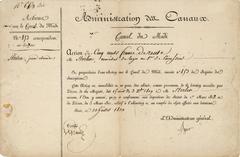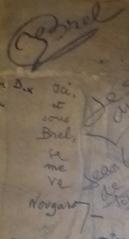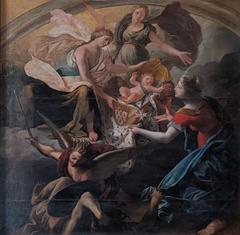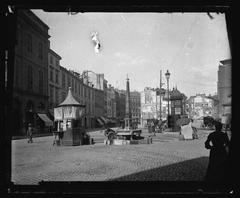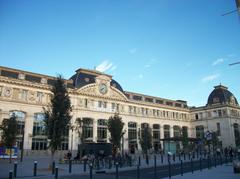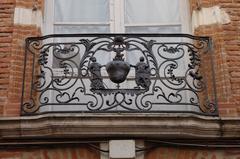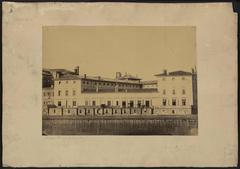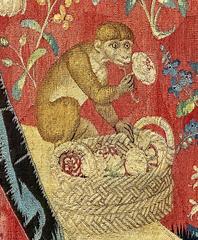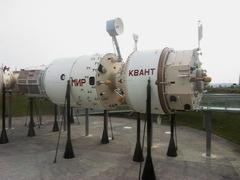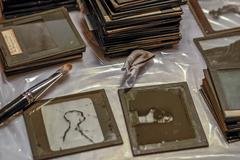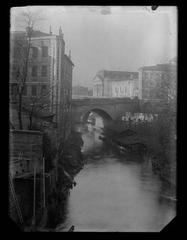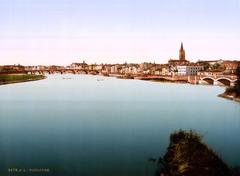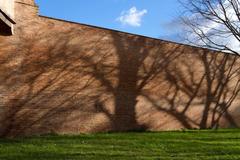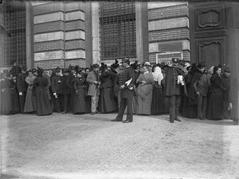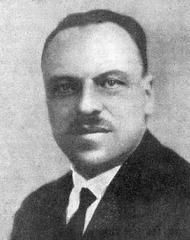Trois-Cocus Toulouse: Visiting Hours, Tickets, and Historical Sites Guide
Date: 04/07/2025
Introduction
Nestled in the northern sector of Toulouse, France, Trois-Cocus is a district that seamlessly blends a rich historical legacy with vibrant community life and ambitious urban renewal. Once a semi-rural hub for market gardening and violet cultivation, Trois-Cocus today stands as a testament to Toulouse’s commitment to sustainable, inclusive, and modern urban development. This guide provides comprehensive and up-to-date information for visitors, including details on accessibility, transportation, cultural highlights, and practical tips to enhance your experience in this dynamic neighborhood (Pyrros.fr; Le Journal Toulousain; Tisséo; Solar District Heating).
Table of Contents
- Introduction
- Historical Origins and Etymology
- Urban Evolution and Renewal
- Exploring Trois-Cocus: Practical Visitor Information
- Trois-Cocus Metro Station: Architecture, Hours, and Art
- Key Attractions and Sites
- Social and Cultural Life
- Practical Visitor Tips
- Frequently Asked Questions (FAQ)
- Nearby Attractions and Future Prospects
- Conclusion
- References
Historical Origins and Etymology
The name “Trois-Cocus” is rooted in a blend of Occitan culture and Napoleonic legend. Originally “Tres Cocuts” in Occitan, meaning “Three Cuckoos,” the district was named after a seigneurial building adorned with three cuckoo bird sculptures. During the Napoleonic era, soldiers misheard the name as “Trois Cocus”—which translates to “Three Cuckolds” in French—resulting in the neighborhood’s memorable and quirky designation (Pyrros.fr). Today, this linguistic heritage lives on in local landmarks like the “sentier des 3 coucous” (Three Cuckoos Path) and “Place des Trois Cocus,” both of which feature Occitan subtitles that honor the district’s roots.
Urban Evolution and Renewal
Historically, Trois-Cocus was an agricultural zone famed for market gardening and contributing to Toulouse’s reputation as the “City of Violets.” The district’s transformation accelerated in the post-war era, with the development of large-scale social housing to accommodate a growing population. Since 2007, Trois-Cocus has been at the heart of one of Toulouse Métropole’s most ambitious urban renewal efforts. This multi-year project has introduced new housing, modernized commercial and public spaces, expanded green infrastructure, and prioritized sustainable transport, all aimed at fostering a vibrant, inclusive community (Le Journal Toulousain; Solar District Heating).
Exploring Trois-Cocus: Practical Visitor Information
Visiting Hours
Trois-Cocus is an open and accessible district. Public spaces—including parks, markets, and squares—are usually open from dawn to dusk. The weekly market at Place Micoulaud operates every Wednesday between 7:00 and 13:30, featuring local produce and regional specialties (Haute-Garonne Tourisme).
Tickets and Entry
There are no entrance fees to access streets, squares, or parks in Trois-Cocus. All public areas are accessible free of charge.
Accessibility
Trois-Cocus is highly accessible via Toulouse Metro Line B, with stations at Trois-Cocus and La Vache. Multiple bus routes and excellent road links facilitate easy connections from other districts. The neighborhood features pedestrian-friendly paths, including the “sentier des 3 coucous,” and is integrated into Toulouse’s cycling network.
Guided Tours and Events
While there are no regularly scheduled guided tours specifically for Trois-Cocus, the Toulouse tourism office and local associations occasionally organize neighborhood walks and cultural events. Check Toulouse Tourisme and local community boards for updated listings.
Trois-Cocus Metro Station: Architecture, Hours, and Art
Design and Features
Opened in 2007 and designed by the Puig & Pujol architectural firm, the Trois-Cocus Metro Station is a standout example of contemporary urban architecture. Its design features glass, steel, and concrete, creating a bright and inviting atmosphere that reflects the district’s modern transformation (metrotoulouse.com). The station is also notable for its integration of public art, with digital installations by Pierrick Sorin and creative elevator designs by local artists.
Metro Station Hours and Tickets
- Operating Hours: 5:15 a.m. to midnight (weekdays), extended to 3:00 a.m. on Fridays and Saturdays (fr.wikipedia.org).
- Ticketing: Tickets are available from automated machines before the platform. Options include single rides, day passes, and contactless payment methods. Fare details are available on Tisséo’s official site.
Passenger Services
The station is fully accessible, with elevators, ramps, and wide turnstiles. Multilingual signage, real-time information screens, and regular maintenance contribute to a comfortable and safe passenger experience.
Intermodality and Connectivity
Trois-Cocus station is a key intermodal hub, connecting Metro Line B with Tisséo bus lines 41 and 60. The nearby VélôToulouse bike-sharing station (#244) enables eco-friendly, last-mile travel. Located between Borderouge and La Vache stations, Trois-Cocus offers efficient north-south transit.
Artistic Highlights
The station features playful digital art by Pierrick Sorin, with animated screens depicting caricatures of passengers. Elevator cabins are uniquely decorated by Toulouse-based designers, enhancing the journey with creative flair (metrotoulouse.com). These programs reflect the city’s commitment to accessible public art.
Key Attractions and Sites
Parc de la Cité Blanche
A central green space offering pedestrian and cycling paths, play areas, and community gathering spots. The park serves as both a biodiversity haven and a focal point for district events (horizons-paysages.com).
Place des 3 Cocus
This vibrant main square is home to regular markets, cultural events, and social gatherings. Surrounded by local shops and cafés, it offers visitors a genuine taste of daily life in Trois-Cocus.
Urban Agriculture and Green Spaces
Northern Trois-Cocus features community gardens and urban farming plots, supporting local food production and environmental education.
Street Art and Cultural Centers
Trois-Cocus is known for its dynamic street art scene. Local associations occasionally organize urban art tours. The area also hosts cultural centers offering exhibitions, workshops, and community programming.
Social and Cultural Life
The district celebrates its diversity, blending long-standing residents with newcomers in a vibrant, multicultural setting. Weekly markets and community events foster social cohesion, while urban renewal initiatives continue to improve public amenities and quality of life.
Practical Visitor Tips
- Getting There: Use Metro Line B to Trois-Cocus or La Vache. Bus lines and cycling infrastructure provide additional options.
- Best Time to Visit: Mornings, especially Wednesdays during the market, offer an authentic local experience. Spring and autumn provide pleasant weather for outdoor activities.
- Safety: Trois-Cocus is generally safe; practice standard urban awareness, especially at night.
- Amenities: Local shops, ATMs, and free Wi-Fi spots are available near the metro station. Pharmacies and clinics are within walking distance.
- Language: French is predominant, but other languages are spoken. Basic French or a translation app is helpful.
- Dining: Enjoy a range of eateries, from French boulangeries to international cuisine. Weekly markets feature regional specialties.
Frequently Asked Questions (FAQ)
Q: Are there entrance fees for Trois-Cocus attractions?
A: No, all public spaces and parks are free to access.
Q: What are the Trois-Cocus Metro Station hours?
A: 5:15 a.m. to midnight on weekdays; until 3:00 a.m. on Fridays and Saturdays.
Q: Is Trois-Cocus accessible for people with reduced mobility?
A: Yes, both the metro and most public spaces are equipped for accessibility.
Q: Are guided tours available?
A: Occasional tours are organized by local associations; check the Toulouse tourism website for current offerings.
Q: Is Trois-Cocus family-friendly?
A: Yes, with playgrounds, parks, and community facilities suitable for children.
Nearby Attractions and Future Prospects
Trois-Cocus is strategically located for visits to major Toulouse sites such as the Basilica of Saint-Sernin, Place du Capitole, and the Canal du Midi. Urban renewal projects are ongoing, with innovative initiatives like solar-powered district heating and expanded green spaces shaping the district’s future (solar-district-heating.eu).
Conclusion
Trois-Cocus encapsulates the evolution of Toulouse from its agricultural roots to a modern, multicultural metropolis. The district’s accessible transport, lively markets, green parks, and artistic metro station make it a must-visit for anyone eager to explore the city beyond its historic center. For up-to-date events, tours, and travel tips, download the Audiala app and follow our social media channels. Discover the authentic pulse of Toulouse in Trois-Cocus—a neighborhood where history, community, and innovation converge.
References
- Trois-Cocus Toulouse: History, Visiting Hours, and Urban Renewal (Pyrros.fr)
- Trois-Cocus Metro Station Visiting Hours, Tickets, and Cultural Highlights (MetroToulouse.com)
- Le Quartier Trois Cocus à Toulouse se prépare à une transformation (Le Journal Toulousain)
- Visiting Trois-Cocus District in Toulouse: Attractions, History, and Travel Tips (Solar District Heating)
- Toulouse Metro Information (Tisséo)
- Official Toulouse Tourism (Toulouse Tourisme)
- Trois-Cocus Metro Station (Wikipedia)

